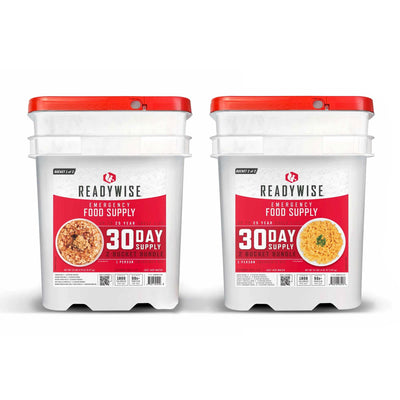In an emergency situation, having reliable food options can be the difference between comfort and chaos. Fortunately, freeze-dried food is lightweight, nutrient-dense, and long-lasting, providing you and your loved ones with sustenance you can rely on.
That said, how long does freeze dried food last?
The typical shelf life ranges up to 25 years; however, its true longevity will depend on factors such as packaging, storage conditions, and ingredient quality. That’s the reason why freeze-dried food is rising in popularity among preppers, outdoor enthusiasts, and emergency planners—and why we’re walking you through freeze-dried basics and tips to maximize its usability.
What Is Freeze-Dried Food?
For ready-to-eat meals on the go, many people reach for freeze-dried food: a type of food product that’s been almost completely dehydrated. This food preservation method involves removing nearly all moisture through a process called sublimation: where water transitions directly from a solid (ice) to a gas (vapor) without passing through the liquid phase.1
How is this done?
First, processors will freeze the food—be it berries, soup mix, or meatballs. The frozen water is then removed and the food is dried to eradicate any remaining water molecules. What remains is a nutrient-dense and portable product that can be:
- Added to emergency kits
- Taken on outdoor adventures
- Incorporated into long-term food supply solutions
How Long Does Freeze-Dried Food Last?
The typical shelf life of freeze-dried food is 25 years.
That said, commercial products—freeze-dried foods found in emergency starter kits, for instance—often outlast homemade options by a significant margin. This disparity is due to differences in processing techniques, packaging, and storage conditions.
For example, commercial producers will use high-tech freeze-drying equipment to thoroughly remove moisture and seal products in specialized, airtight packaging. Homemade freeze-drying equipment may not achieve the same level of dehydration or preservation, which may make the product more vulnerable to spoiling or microbial growth.
Factors That Affect Shelf Life
There are several factors that may affect the shelf-life of a freeze-dried product. These include:
- Packaging – Vacuum-sealed Mylar bags with oxygen absorbers protect freeze-dried food from air, moisture, and oxidation, ensuring a longer shelf life.
- Storage conditions – Cool temperatures (below 75°F), low humidity, and minimal light exposure are essential for preserving quality and preventing spoilage.
- Quality of ingredients – Fresh, low-moisture foods freeze-dry best and maintain their flavor, texture, and nutrients longer than high-fat or high-moisture options.
Benefits of Long Shelf Life
Freeze-dried food is a cornerstone of emergency preparedness, offering unmatched reliability due to its extended shelf life of up to 25 years.
Unlike canned food, which requires regular rotation every few years, freeze-dried food minimizes the need to re-stock, ensuring your emergency stash remains ready whenever you need it. Ultimately, its longevity, lightweight nature, and preserved nutrients make it a dependable solution for long-term planning and peace of mind.
Signs Freeze-Dried Food Has Expired
If freeze-dried food is not stored or packaged properly, it may spoil. Before eating your meal, inspect your food for signs that it may have gone bad, such as:
- Discoloration – Look for unusual color changes, such as dark spots, fading, or uneven tones, which may indicate mold growth or other contamination.
- Unusual odors – Smell the food for any sour, rancid, or chemical-like odors, as these can signal spoilage or microbial growth.
- Compromised packaging – Check for damage to the packaging, such as punctures, tears, or an unsealed vacuum. Swollen bags may indicate bacterial activity, while moisture inside suggests the food has rehydrated and is unsafe to eat.
Tips to Maximize Freeze-Dried Food Shelf Life
Proper storage is essential for preserving the quality and longevity of freeze-dried food. Here are actionable tips to help maximize its shelf life:
- Store in a cool, dark place – Keep your freeze-dried food in a location with stable, cool temperatures to slow down nutrient degradation and prevent spoilage. Also, avoid areas with direct sunlight or fluctuating heat, such as attics or garages.
- Use airtight containers – For added protection, store Mylar bags or other original packaging inside airtight containers. This shields the food from pests (and pets), humidity, and accidental punctures.
- Regularly check its packaging – Inspect your food supplies for any signs of compromised packaging, such as tears, holes, or unsealed bags. If you notice damage, repackage the food promptly to maintain its integrity or discard it if the food has gone bad.
Freeze-Dried Food for Everyday Use
Freeze-dried food isn't just a lifesaver in emergencies—it's also perfect for camping, backpacking, or quick meal prep—without the need for refrigeration or cooking equipment.
The best part?
Rehydrating freeze-dried food requires minimal effort. Simply add hot water, stir, and wait a few minutes for a ready-to-eat meal.
Is Freeze-Dried Food Worth It?
While the initial cost of freeze-dried food may be higher, freeze-dried food offers excellent value for long-term storage due to its 25-year shelf life—far surpassing canned goods (two to five years) and dehydrated food (a few months to several years). This reduces the need for frequent replacements and waste, making it a more cost-effective option in the long run.
Freeze-dried meals are also lightweight, space-efficient, and easy to prepare, making them a smart investment for long-term storage, especially for emergencies, outdoor activities, and meal prep.
The Longevity of Freeze-Dried Food
Ultimately, freeze-dried food is a viable investment for outdoor enthusiasts, emergency planners, and meal preppers alike—providing a convenient, nutritious, and long-lasting meal option, whether you’re on the go or at home.
At ReadyWise, we serve up survival food supplies you can rely on.
Complete your emergency food supply with starter items like our 72 Hour Food Kit or plan for the long term with a year-long emergency food supply, which includes pancake mix and BBQ beans, alongside pasta and rice varieties.
No matter where you go, ReadyWise is here to ensure you're prepared with high-quality, ready-to-eat meals that last.
Sources:
- Healthline. How Does Freeze-Drying Work and Are Freeze-Dried Foods Healthy?. https://www.healthline.com/nutrition/freeze-drying
















































































